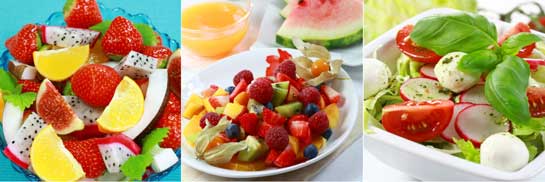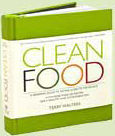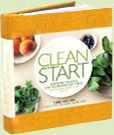


Clean Food: A Seasonal Guide to Eating Close to the Source With More Than 200 Recipes for a Healthy and Sustainable You ($30, 304 pages)
 Clean Start: Inspiring You to Eat Clean and Live Well With 100 New Clean Food Recipes ($25, 176 pages) by Terry Walters (Sterling Epicure)
Clean Start: Inspiring You to Eat Clean and Live Well With 100 New Clean Food Recipes ($25, 176 pages) by Terry Walters (Sterling Epicure)
When the concept of mind-body exercise first came on the scene, it was met with more than a few naysayers. After all, science had yet to really examine the link between mind and body, and many people simply viewed it as a New Age trend that shouldn’t be taken seriously. Of course, things have changed considerably and now mind-body exercise is an integral part of fitness and health. The Clean Food movement (sometimes referred to as the Slow Food movement), recently popularized by writers like Michael Pollan and numerous celebrities, encourages readers to make the same type of connection with food, not only to mind and body, but to the environment as well.
Certainly, this isn’t a novel concept—experts have long been advising us to choose a variety of whole foods, which means eating them as close to their original form as possible (e.g., a piece of fruit instead of a fruit roll-up). And The New York Times wrote about clean food in 1996, although it was presented more as a luxury of the upper class, as opposed to a back-to-the-basics approach to eating well.
Two recently published books, Clean Food: A Seasonal Guide to Eating Close to the Source With More Than 200 Recipes for a Healthy and Sustainable You and its follow-up, Clean Start: Inspiring You to Eat Clean and Live Well With 100 New Clean Food Recipes, aim to bring this concept to the masses by promoting foods that are “naturally grown and minimally processed.” For the author Terry Walters, a health counselor and food educator, this means consuming a mostly vegan diet and eating foods that are in season (rather than shipped in from thousands of miles away).
“What we know for sure is that the more a food is processed, the more its nutrients are lost.”
Clean Food, the larger of the two books, is visually sparer, with no photographs, but each recipe section is color-coded by season. Clean Start includes photographs of a small portion of recipes, but these are beautifully done. Both books open with information about this dietary approach, with Clean Start focusing more on practical information like stocking the kitchen and pantry, suitable substitutions, and cooking basics for legumes and grains. Clean Food also includes this information, but spends more time explaining the reasoning behind eating clean, and offers advice on how to not only enhance the eating experience, but to also increase your overall well-being (e.g., eat more slowly, stop eating three hours before bedtime, make peace with your food choices).
Both books are organized into spring, summer, fall and winter chapters, highlighting the seasonal foods that are most plentiful at each time of year. The recipes are, for the most part, uncomplicated, although some of the ingredients may be unfamiliar to many, particularly given her heavy emphasis on sea vegetables for their mineral content. And while both books eschew meat and dairy products, the recipes in Clean Start are also gluten-free. In most recipes, soy-based products serve as the primary source of protein, although the author acknowledges the questions many people have about the health benefits (or concerns) about soy, particularly the processed soy that is found in so many products. She also discusses other hot health topics, such as organic vs. conventional foods, the prevalence of high fructose corn syrup, and the possible nutrient-inhibiting effects of oxalic and phytic acids, which are found in some vegetables, grains and legumes.
It is her handling of these more controversial topics that sets Walters’ books apart from many other similarly focused food guides and cookbooks. Rather than make equivocal statements, Walters takes a soft-sell approach by acknowledging that a vegan diet is not a requirement for everyone. This is a marked change from books like Skinny Bitch and Fast Food Nation that aim to scare or disgust readers into avoiding certain foods. Rather, Walters recommends making small changes over time that will “allow our body and your life to adapt more easily and are more likely to be long lasting.” And, even more surprisingly, she recognizes that paying too much attention to what we eat isn’t healthy either. “It’s just food, after all,” she writes.
“We try diets like we try hairstyles and the possibilities are infinite, but are we well served by adhering to one defined, and perhaps limited, approach to eating?”
However, like other food writers before her, such as Michael Pollan and Alice Waters, Walters does make the connection between the food we buy and consume and its resultant effects on the environment. While eating tomatoes and strawberries year round is now commonplace and relatively inexpensive, the subsequent cost to the planet is considerable. Again, Walters is not militant in her recommendations, but instead extols the nutritional and feel-good benefits of buying local as often as possible. Although she is not alone in making this argument, it is not one that all readers are eager to embrace.
Both books feature appealing recipes—Clean Food, for example, offers some amazing dessert options, including a fresh fruit tart with almond crust and chocolate pecan pie, while Clean Start features polenta pizzas with several topping options, and energy squares that are far superior to any store-bought bars.
Ultimately, both of these books will largely appeal to those who are more adventurous cooks and eaters. After all, it takes time to adapt to new flavors and techniques and to try new things—even more so if you are preparing food for children. And her message of choosing locally grown, minimally processed foods with the intention of nourishing both body and soul will resonate with those who are less focused on losing weight and more intent on making the connection between how they eat and how they feel and live.